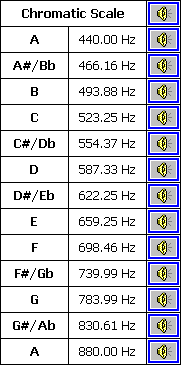(1.10) Chromatic Scale Notes
The Chromatic scale could start on any note, but would always end up containing the same notes (because it contains all notes). So in practice, there is only one Chromatic scale.
The table below shows the frequencies of the twelve notes between note A at 440 Hz, and note A one octave up from it.

Higher pitched notes have larger frequency steps (in Hertz) between them, but each step makes an equal change to difference in pitch (one semitone) that we perceive.
Even though there are twelve notes in an octave, only the first seven letters of the alphabet are used to name them (from A to G). We'll look at the reason for this later.
The other five notes of the Chromatic scale are named by placing a sharp (♯) symbol after a note letter to make it one semitone higher, or by placing a flat (♭) symbol after a note letter to make it one semitone lower.
Often there are two name choices for these other five notes. For example, the note A♭ in the table above could also be called G♯. Sometimes, as we'll see later, there is a definite rule for which name is more appropriate.
|
Topic 14 of 117
| ||
Bring these music concepts to life with the free Songtrix Bronze Edition as you create songs from chords and scales.
Then publish and share your ideas with the other musicians you meet on the ChordWizard Network.
Have questions? Join the ChordWizard Network and post them in the Music Theory forum for answers and discussions on your topics of interest.








